woodwinds
All scores that include a part for at least one woodwind instrument.
Bauer – Sonata, Op.22 – Alto Saxophone
 Sonata, Op.22, by Marion Bauer
Sonata, Op.22, by Marion BauerTranscribed for Alto Saxophone (and piano) by Paul Cohen (originally for viola and piano)
Alto Saxophone Part, PDF $11.79
Paul Cohen is one of America's most sought-after saxophonists for orchestral and chamber concerts and solo recitals. In addition to being a renowned performer and recording artist, he is also a talented arranger, lecturer, and collector of rare and historical instruments. Dr. Cohen holds MM and DMA degrees from the Manhattan School of Music; he currently serves on the faculties of the Manhattan School of Music and Rutgers University. We at NSM were pleased for the opportunity to collaborate with him on this publication of his transcription of Marion Bauer’s Sonata for alto saxophone.
from Dr. Paul Cohen’s preface to the NSM edition © April 7, 2021:
“Bauer composed this sonata in 1932 or 1935. It originally was written for viola, and dedicated to the memory of her friend and colleague, Albert Stoessel who was a distinguished American violinist, conductor, author, composer, and educator in the 20th century. Bauer soon after created her own idiomatic transcription for clarinet and piano, and the sonata was published as a work for viola or clarinet in 1951. It is revealing to see the differences in the viola and clarinet versions. The piano part remains unchanged in both.
 There is a history of music for viola successfully adapted for saxophone by the composers. Fernande Decruck’s Sonata (1943) for saxophone and piano (or orchestra) was originally written for viola, as was Ross Lee Finney’s Sonata in A Minor from 1937 (viola and piano), adapted for saxophone in the early 1970s. Several works for alto saxophone and orchestra written for the American saxophonist Elise Hall were originally written for viola, including Florent Schmitt’s Legende (1918) and Choral Variee´ (1903) by Vincent D’Indy. Adolph Busch composed his Suite for violin and either viola or alto saxophone in 1926, while in 1923 Darius Milhaud replaced the viola with the saxophone in La Creation du Monde literally positioning the saxophone in the viola chair in the string section. My saxophone adaptation of Bauer’s Sonata combines elements of the clarinet and viola versions, creating a version appropriate for the alto saxophone. This includes changes in range, articulation, phrasing and dynamics to create an idiomatic (though challenging) version for the alto saxophone faithful to the musical intent of the composer.”
There is a history of music for viola successfully adapted for saxophone by the composers. Fernande Decruck’s Sonata (1943) for saxophone and piano (or orchestra) was originally written for viola, as was Ross Lee Finney’s Sonata in A Minor from 1937 (viola and piano), adapted for saxophone in the early 1970s. Several works for alto saxophone and orchestra written for the American saxophonist Elise Hall were originally written for viola, including Florent Schmitt’s Legende (1918) and Choral Variee´ (1903) by Vincent D’Indy. Adolph Busch composed his Suite for violin and either viola or alto saxophone in 1926, while in 1923 Darius Milhaud replaced the viola with the saxophone in La Creation du Monde literally positioning the saxophone in the viola chair in the string section. My saxophone adaptation of Bauer’s Sonata combines elements of the clarinet and viola versions, creating a version appropriate for the alto saxophone. This includes changes in range, articulation, phrasing and dynamics to create an idiomatic (though challenging) version for the alto saxophone faithful to the musical intent of the composer.”For additional information about Marion Bauer, please see the text excerpted from Peter H. Bloom’s preface to NSM’s 2014 publication of his transcription of the Sonata for alto flute.
We provide only the transcribed alto saxophone part in our edition; a pdf of the piano score is available from imslp.org.
Alto Saxophone Part, 11 pages; Total, 14 pages
PreviewDvořák – Romance, Op. 11 – trans. Clarinet
 Romance, Op. 11 by Antonín Dvořák
Romance, Op. 11 by Antonín DvořákTranscribed for B♭ Clarinet by C. A. Vater (originally for violin)
Part for B♭ Clarinet, PDF $6.97
Czech composer Antonín Dvořák based his Romance, Opus 11 on the slow movement of his String Quartet in F minor, composed in 1873, re-working that Andante con moto quasi allegretto to create two versions of the Romance, one for solo violin and orchestra (B.39) and another for solo violin and piano (B.38). The Romance is one of Dvořák’s most magnificent melodic works, teaming with romance, lyricism, and emotional intensity. Understandably, the piece became extremely popular and has been transcribed for several other instruments, including viola, cello, guitar, and flute. In creating an NSM edition of the work for clarinet (and piano), we have incorporated several changes in the solo part to account for sonic differences between the clarinet and the violin. In so doing, every effort has been made to maintain the spirit, character, and flow of Dvořák’s original composition. We provide here our transcribed B♭ clarinet part only; the score for violin and piano is readily available in the public domain as a free pdf download from imslp.org, and that piano part can be used in performance along with our clarinet part.
B♭ Clarinet part, 4 pages; Total, 6 pages.
PreviewElgar – Salut d’Amour – Alto Flute & Piano
 Salut d’Amour, Op. 12, by Edward Elgar
Salut d’Amour, Op. 12, by Edward ElgarTranscribed for Alto Flute and Piano by C. A. Vater
Piano Score and Part for Alto Flute, PDF $6.99
The English composer Edward Elgar held many positions throughout his career, including those of organist at St. George’s Roman Catholic Church in Worcester, conductor of the Worcester Philharmonic, Professor of Music at the University of Birmingham, and conductor of the London Symphony Orchestra. He achieved considerable prominence as a result of his many successful orchestral, vocal, and chamber music compositions. Elgar composed this piece in 1888, as an engagement gift to his beloved future wife. Though first written for piano solo, arrangements were created shortly thereafter by the composer himself for violin and piano, and for orchestra. Originally titled “Liebesgruss” (Love’s Greeting), but later changed to Salut d’Amour, the piece is now one of Elgar’s most widely recognized works, and its immense popularity has led to arrangements for a wide variety of other instruments. We provide here a transcription of Salut d’Amour for alto flute and piano, which has been adapted from the editions published by Schott for violin and piano, oboe and piano, or orchestra and which are now in the public domain.
Score, 4 pages; Alto Flute part, 2 pages; Total, 10 pages.
Preview
Elgar – Mot d’Amour – Alto Flute & Piano
 Mot d’Amour, Op.13, No.1, by Edward Elgar
Mot d’Amour, Op.13, No.1, by Edward ElgarTranscribed for Alto Flute and Piano by C. A. Vater
Piano Score and Part for Alto Flute, PDF $5.49
In 1888, Elgar composed Salut d’Amour, now one of his most-recognized pieces, as an engagement gift for his beloved fiancée. Later he wrote Mot d'Amour (Love's Word) for violin and piano as a companion piece to Salut d’Amour. Mot d'Amour, which was initially given the German title Liebesahnung, was published in 1889 by Osborn & Tuckwood in the edition 2 Pieces for Violin & Piano that included this piece and a second one, less well-suited to alto flute, called Bizarrerie. Mot d’Amour is similar to Salut d’Amour in being light, charming, and highly romantic. Although Mot d’Amour never attained the level of popularity achieved by the earlier work, it is considered by some to be the finer composition (https://www.elgar.org/3salut.htm). Both Salut d’Amourand Mot d'Amoursound especially rich and mellow when performed on alto flute, and both pieces are now available from Noteworthy Sheet Music as transcriptions for alto flute and piano, adapted from the composer’s violin and piano editions now in the public domain and available on imslp.org.
Score, 4 pages; Alto Flute part, 1 page; Total, 8 pages.
Falla - Siete Canciones populares Españolas - Alto Flute (& piano)
 Seven Spanish Folksongs, by Manuel de Falla
Seven Spanish Folksongs, by Manuel de FallaTranscribed for Alto Flute (and piano) by C. A. Vater
Alto Flute part, PDF $8.99
Manuel de Falla (1876-1946) is regarded as one of the greatest Spanish composers of the twentieth century. His Siete canciones populares españolas (“Seven Spanish Folksongs”) is a cycle of traditional songs from various regions of Spain set for voice and piano. Written in 1914, the work quickly became very popular: in 1925, six of the seven songs were arranged for violin and piano as the Suite populaire espagñole by the Polish violinist, composer and arranger Paul Kochánski, and subsequent versions were designed for solo piano, voice and guitar, piano and cello, and orchestra. We created the Noteworthy Sheet Music alto flute part by adapting ideas from both the Falla vocal line and the Kochánski violin line, modifying pitches, articulations, dynamics, etc. as needed to best suit the alto flute’s range and style. Our alto flute part is intended to be accompanied by piano using the original Falla score for voice and piano, which is available as a free downloadable pdf at imslp.org; we provide only the transcribed alto flute part in the NSM edition.The seven songs included in the original voice and piano publication, as well as in our alto flute part edition, are El Paño Moruno (“The Moorish Cloth”), Seguidilla murciana (an old dance form, omitted in the Kochánski violin and piano version), Asturiana (a lament from the northern part of Spain), Jota (a familiar dance form from the north east of Spain), Nana (an Andalusian lullaby), Canción (“Song”), and Polo (reminiscent of the zapateado, a Spanish dance rich in flamenco rhythms). This information and an in-depth analysis of the Siete canciones populares españolas, including historical and regional background, music analysis, and an English translation of the lyrics, can be found in the excellent article by composer and conductor Gianmaria Griglio, co-founder and Artistic Director of ARTax Music.
Alto Flute part, 8 pages; Total,10 pages. (pdf of piano accompaniment is freely available at imslp.org)
Preview
Massenet - On Dit! - trans. Clarinet, Voice and Piano
 On Dit!, by Jules Massenet
On Dit!, by Jules MassenetTranscribed for Clarinet, Voice and Piano by C. A. Vater
Score for Clarinet, Voice and Piano; Alternative Parts for A-Clarinet and B-flat-Clarinet, PDF $8.99
Massenet’s composition On dit! is a musical setting of the eponymous poem by Jean Roux in which the poet ponders how the word “love” is commonly and inevitably associated with the sweetness and delights of spring. In addition to the vocal line and piano accompaniment, Massenet provided On dit! with a prominent part for cello. The cello line can be readily adapted for clarinet, creating a lovely and suitable new version of the piece for clarinet, voice, and piano. Our Noteworthy Sheet Music edition includes a score in concert pitch, as well as individual parts for either A-clarinet or B-flat-clarinet transcribed from the original cello part. Clarinetists in possession of both A and B-flat instruments may develop a personal preference for playing this piece on one instrument over the other, based on tone quality, complementarity with a particular singer’s sound, etc.
Score, 5 pages; A-Clarinet Part, 2 pages; B-flat-Clarinet Part, 2 pages; Total, 16 pages.
PreviewSchumann, Clara – Sechs Lieder - trans. for Alto Flute (and piano)
 Sechs Lieder, by Clara Schumann
Sechs Lieder, by Clara SchumannTranscribed for Alto Flute by C. A. Vater
Part for Alto Flute (in lieu of voice); PDF $5.99
In her Sechs Lieder, Op. 13, Clara Schumann set to music six German poems—two written by Heinrich Heine (Ich stand in dunklen Träumen and Sie liebten sich beide), three by Emanuel Geibel (Liebeszauber, Der Mond kommt still gegangen, and Die stille Lotosblume) and one by Friedrich Rückert (Ich hab’ in deinem Auge). Many of Clara Schumann’s songs were composed as gifts for her beloved husband Robert; they are romantic, melodic and highly expressive, and the Sechs Lieder of Op. 13 appropriately convey the broad array of intense emotions portrayed in the poetry that inspired them. These songs, which are absolutely charming, are nicely adaptable for a solo instrument in lieu of voice. They have been transcribed previously for violin or cello, and likely other instruments as well, but are particularly lovely when played on either alto flute or clarinet, instruments for which the voice line falls completely in range. Our Noteworthy Sheet Music editions of Op. 13 for alto flute or clarinet do not include re-notated versions of the score, since a high-quality PDF of the original piano and voice score is available free of charge in the public domain, and that piano accompaniment works perfectly well with our instrumental transcriptions of the voice line. The score we used when creating our parts may be downloaded from the IMSLP website. For NSM’s clarinet transcription of the Sechs Lieder voice line, please click the link.
Alto Flute Part, 4 pages; Total, 6 pages.
Preview
Schumann, Clara – Sechs Lieder - trans. for Clarinet (and piano)
 Sechs Lieder, by Clara Schumann
Sechs Lieder, by Clara SchumannTranscribed for Clarinet by C. A. Vater
Part for B-flat Clarinet (in lieu of voice); PDF $5.99
In her Sechs Lieder, Op. 13, Clara Schumann set to music six German poems—two written by Heinrich Heine (Ich stand in dunklen Träumen and Sie liebten sich beide), three by Emanuel Geibel (Liebeszauber, Der Mond kommt still gegangen, and Die stille Lotosblume) and one by Friedrich Rückert (Ich hab’ in deinem Auge). Many of Clara Schumann’s songs were composed as gifts for her beloved husband Robert; they are romantic, melodic and highly expressive, and the Sechs Lieder of Op. 13 appropriately convey the broad array of intense emotions portrayed in the poetry that inspired them. These songs, which are absolutely charming, are nicely adaptable for a solo instrument in lieu of voice. They have been transcribed previously for violin or cello, and likely other instruments as well, but are particularly lovely when played on either alto flute or clarinet, instruments for which the voice line falls completely in range. Our Noteworthy Sheet Music editions of Op. 13 for alto flute or clarinet do not include re-notated versions of the score, since a high-quality PDF of the original piano and voice score is available free of charge in the public domain, and that piano accompaniment works perfectly well with our instrumental transcriptions of the voice line. The score we used when creating our parts may be downloaded from the IMSLP website. For NSM’s alto flute transcription of the Sechs Lieder voice line, please click the link.
B-flat Clarinet Part, 4 pages; Total, 6 pages.
Preview
Bridge – Two Pieces: Pensiero and Allegro appassionato – trans. for Clarinet and Piano
 Two Pieces: Pensiero and Allegro appassionato, by Frank Bridge
Two Pieces: Pensiero and Allegro appassionato, by Frank BridgeTranscribed for B-flat Clarinet and Piano by C.A.Vater
Score and Part; PDF $10.99
Certain chamber works written for viola can also work very beautifully when transcribed for clarinet, and indeed may actually be coveted by clarinetists. Brahms’ Two Songs for Voice, Viola and Piano, Op. 91 is one such piece, and our transcription has become one of NSM’s most popular publications. Clarinetists may discover that our adaptation of the viola part of Frank Bridge’s Two Pieces: Pensiero and Allegro appassionato, written for viola and piano, is also well-conceived and enjoyable to play. As suggested by their titles, these two pieces were written in very different styles, but they complement each other well, showing off Bridge’s composing versatility and providing performers an opportunity to display a range of emotions and capabilities. In our edition, we have raised the Pensiero key from F minor to G minor, taken a few passages in both pieces 8va to bring them into clarinet range, and created clarinet-friendly adaptations for the viola’s occasional double stops, but otherwise the pieces remain as Bridge composed them.
Score, 10 pages; Clarinet part, 3 pages; Total, 16 pages.
Preview
Glazunov - Chant du Ménestrel - trans. for A-Clarinet and Piano
 Glazunov - Chant du Ménestrel, Op.71, by Alexander Glazunov
Glazunov - Chant du Ménestrel, Op.71, by Alexander GlazunovTranscribed for A-Clarinet and Piano by C.A.Vater
Score and Part; PDF $7.99
Alexander Glazunov (1865-1936) was an eminent composer in the late Russian romantic tradition. In 1901, he published two versions of hisChant du Ménestrel, one for cello and orchestra and another for cello and piano, dedicating the work to Alexandre Wierzbilowicz, principal cello at the Russian Imperial Opera Orchestra and a professor at the Conservatory. Chant du Ménestrel (Minstrel’s Song) is a sorrowful, romantic piece that evokes the image of a Russian troubadour wandering the countryside, singing his sad songs. The lyrical, expressive solo cello line is without double stops and readily transcribed for other instruments. Written in the key of F# minor, this short work (average duration 3-4 minutes) adapts especially well for A-clarinet.
Score, 4 pages; A-Clarinet part, 2 pages; Total, 10 pages.
Preview
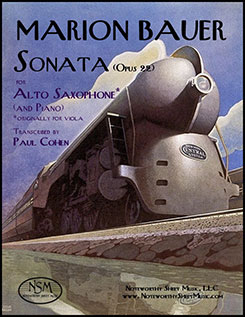
 There is a history of music for viola successfully adapted for saxophone by the composers. Fernande Decruck’s Sonata (1943) for saxophone and piano (or orchestra) was originally written for viola, as was Ross Lee Finney’s Sonata in A Minor from 1937 (viola and piano), adapted for saxophone in the early 1970s. Several works for alto saxophone and orchestra written for the American saxophonist Elise Hall were originally written for viola, including Florent Schmitt’s Legende (1918) and Choral Variee´ (1903) by Vincent D’Indy. Adolph Busch composed his Suite for violin and either viola or alto saxophone in 1926, while in 1923 Darius Milhaud replaced the viola with the saxophone in La Creation du Monde literally positioning the saxophone in the viola chair in the string section. My saxophone adaptation of Bauer’s Sonata combines elements of the clarinet and viola versions, creating a version appropriate for the alto saxophone. This includes changes in range, articulation, phrasing and dynamics to create an idiomatic (though challenging) version for the alto saxophone faithful to the musical intent of the composer.”
There is a history of music for viola successfully adapted for saxophone by the composers. Fernande Decruck’s Sonata (1943) for saxophone and piano (or orchestra) was originally written for viola, as was Ross Lee Finney’s Sonata in A Minor from 1937 (viola and piano), adapted for saxophone in the early 1970s. Several works for alto saxophone and orchestra written for the American saxophonist Elise Hall were originally written for viola, including Florent Schmitt’s Legende (1918) and Choral Variee´ (1903) by Vincent D’Indy. Adolph Busch composed his Suite for violin and either viola or alto saxophone in 1926, while in 1923 Darius Milhaud replaced the viola with the saxophone in La Creation du Monde literally positioning the saxophone in the viola chair in the string section. My saxophone adaptation of Bauer’s Sonata combines elements of the clarinet and viola versions, creating a version appropriate for the alto saxophone. This includes changes in range, articulation, phrasing and dynamics to create an idiomatic (though challenging) version for the alto saxophone faithful to the musical intent of the composer.”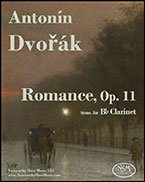 Romance, Op. 11 by Antonín Dvořák
Romance, Op. 11 by Antonín Dvořák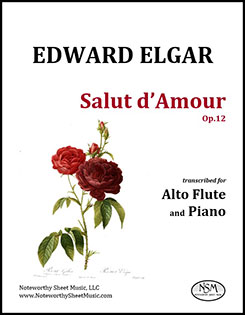
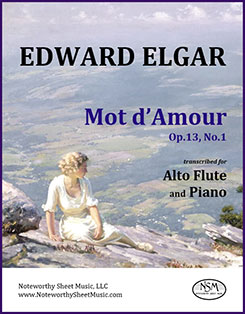 Mot d’Amour, Op.13, No.1, by Edward Elgar
Mot d’Amour, Op.13, No.1, by Edward Elgar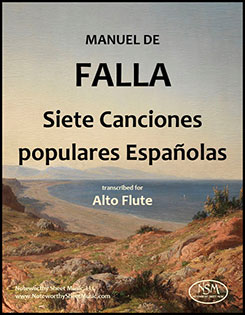 Seven Spanish Folksongs, by Manuel de Falla
Seven Spanish Folksongs, by Manuel de Falla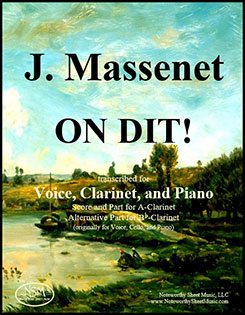
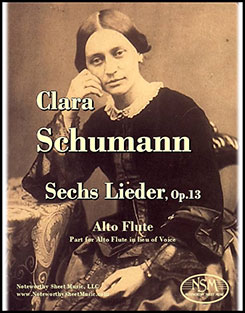 Sechs Lieder, by Clara Schumann
Sechs Lieder, by Clara Schumann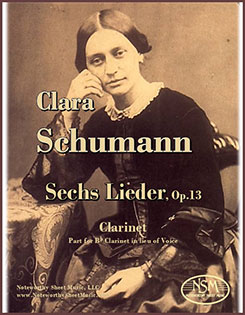 Sechs Lieder, by Clara Schumann
Sechs Lieder, by Clara Schumann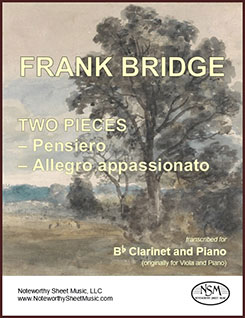 Two Pieces: Pensiero and Allegro appassionato, by Frank Bridge
Two Pieces: Pensiero and Allegro appassionato, by Frank Bridge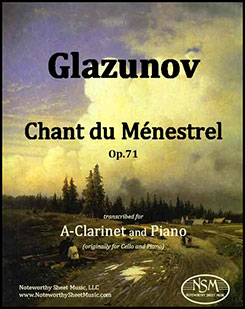 Glazunov - Chant du Ménestrel, Op.71, by Alexander Glazunov
Glazunov - Chant du Ménestrel, Op.71, by Alexander Glazunov